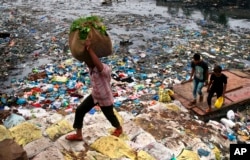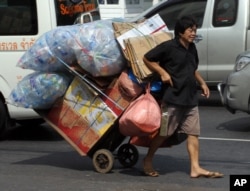A booming plastics and packaging industry in Asia – including China – is being driven by rising incomes and consumption, with analysts saying a growing middle class will add to the rise in plastics demand across the region. But it comes along with a rising environmental alarm over plastic pollution in rivers and oceans.
Online plastics industry websites paint a picture of growth and trade and investment worth billions of dollars to Asian economies.
Robust plastics industry
China has been a regional leader in plastics production rising over the past six decades to capture more than a 20 percent share of global plastics production. Southeast Asia accounts for a further 20 percent of global output.
Economists at Australia’s ANZ Bank say global plastics consumption has roughly tripled over the past 20 years.
“In developing markets, population growth, rising disposable incomes, urbanization, and changing lifestyles will drive this demand even further, particularly for plastic packaging, building and construction, automotive and health care industries,” they said in a recent report.
Vietnam has reported an average growth of 18 percent in the plastics industry, with bags a leading export.
Within the 10 member Association of South East Asian Nations (ASEAN) plastics and plastic products netted the region almost $40 billion in export revenues in 2013.
Thailand is a regional leader in plastics per capita consumption of plastics at 40 kilograms. Malaysia reports 35 kilograms per person and Indonesia is at 17 kilograms per person.
Bad for environment
But the plastics and food packaging industries have a dark side. Plastic pollution in rivers and oceans has at times creating floating islands, and with floating debris and micro-plastics ingested by marine life.
In February, United Nations Environment “declared war on plastics pollution”, launching an “unprecedented” campaign targeting sources of marine litter, micro-plastics in cosmetics and excessive waste of single-use plastics by 2022.
A research paper published in the Nature Communications journal by the Ocean Cleanup – a Dutch Foundation, said between 1.15 and 2.41 million metric tons of plastic waste entered the oceans each year. “The top 20 polluting rivers, mostly in Asia, account for 67 percent of the global total,” the journal read.
China’s Yangtze River reported “considerably higher plastic concentrations” than any other sampled river worldwide” dumping 330,000 metric tons of plastic into the East China Sea. India’s Ganges river is also of major concern to environmentalists.
The U.N. Secretary General Antonio Guterres recently warned unless steps are taken to curb the pollution, plastics could outweigh fish by 2050.
Environmentalists estimate more than eight million tons of plastic ends up in the ocean, impacting ecosystems, killing around one million sea birds, some 100,000 sea mammals and millions of fish.
A U.N. Oceans Conference in early June called on nations to take steps on plastics consumption with China, Thailand, and Indonesia and the Philippines committing to reduce plastics consumption.
Thailand's difficult task
Penchom Saetang, director of Thai–based Ecological Alert and Recovery Thailand (EARTH), said reducing Thai consumption of plastics will be a challenge.
“In my opinion, it’s very difficult because the Thai people are very familiar with the easy going way, easy to use plastics because in Thailand, Thailand is a country that consumers – we have a lot of food and we need plastic bags in every aspect of consumption. So to decrease the plastic is very, very difficult”, Penchom told VOA.
The government in Bangkok has sent out a 20 year strategy for tackling the problem.
But Greenpeace Thailand director, Tara Buakamsri, said although the Thai government has set out a plastic debris management plan, they should now focus on specific goals.
“On the one hand they are looking at a very holistic approach on how to deal with plastic waste. In the other hand they are missing something that is very important – they don’t have a specific target for reduction. It has to set a very ambitious target for this but they maybe it’s something I see missing from the plan,” Tara said.
Food industry
New Zealand based environmental activist Anna Dawson spent three months in the Philippines in 2016. She cycled 2,000 kilometers on a bamboo bike scouring and cleaning beaches of plastics and supporting local communities to reduce plastics use.
Dawson says the food industry should be a target to reduce plastics use.
“The change has to start with food and how we go about eating food – that was probably from the beach cleanups the most clear statistic that came through whether it be compostable packaging or just encouraging people to eat more fresh fruit and veggies – market shopping instead of supermarket shopping,” Dawson told VOA.
Dawson said government policies should focus on reducing plastics production.






